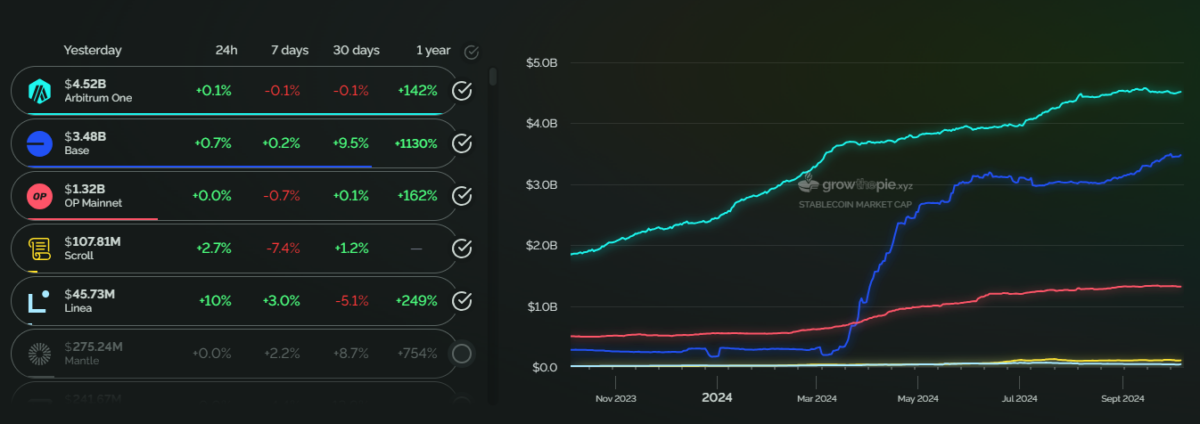More than half of the well-developed L2 platforms host general-purpose traffic. Specialized chains are fewer, and carry only about 10% of total transactions.
L2 chains have varied use cases, but the bulk of traffic is general-purpose. This is how Growthepie classifies most of the available L2 that make up the scalable Ethereum-based economy. While some of the L2 have attracted usable apps, others remain highly generic and find it difficult to draw traffic beyond the initial airdrop farming stage.
For L2 chains, there is always a predominance of one type of traffic. But the bigger the chain, the more non-specific transactions and token transfers it hosts. Mature L2 chains are also beyond their airdrop farming stage, while trying to build organic traffic. The L2 chains make up more than 97% of all active addresses.
Only a handful of L2 chains specifically advertise as a single-purpose network. They include Zora, a dedicated NFT chain, Redstone and ImmutableX for gaming, Rhino.fi, a specialized bridge chain. Specialized L2 Derived and Orderly focus on hosting exchanges and DEX trading activity.
For general-purpose chains, their specialization is usually defined by the leading apps. In the case of the top chains, DeFi apps like Uniswap and Aave. The bulk of Aave activity and value lies in the users of Aave, GMS, and Uniswap, turning it into a DeFi hub. Smaller exchanges like Blast focus on DEX activity and other small-scale native protocols for yield farming.
L2 split on stablecoin inflows
One of te significant splits among L2 chains is whether they are stablecoin recipients. Older chains have a bigger share of stablecoin inflows, with the biggest recipients being Polygon, Optimism, and Arbitrum.
 Arbitrum remains the most liquid L2 by stablecoin supply. | Source: Growthepie
Arbitrum remains the most liquid L2 by stablecoin supply. | Source: Growthepie
Arbitrum remains the biggest stablecoin carrier, still not surpassed by Base and its native USDC mints. Stablecoins have different roles on L2, but mostly serve to boost liquidity for DeFi apps.
Newer, low-fee chains like Blast and Base have minimal stablecoin inflows, instead relying on their native assets and tokens. Chains like Metis, Linea and ZkSync still do not receive stablecoins, but have inflows of bridged ETH.
More L2 are in the pipeline
L2 started out as a batch of VC-backed projects, then moved through the airdrop narrative. Over time, a handful of chains grew a solid user base and established themselves as the go-to hubs for scalable EVM-compatible apps.
The most attractive feature of older L2 remains their connection to the liquidity of Ethereum, a net donor of ETH, tokens, and stablecoins.
In 2024, a long list of new L2 is coming down the pipeline. Like earlier projects, L2 are one of the main focus topics of venture funds. Eight additional L2 projects organized funding rounds in September for a total of more than $56M, while the batch from Q1 already brought forward its star, Taiko.
Balance (EPT) received $30M in a round led by a16z, while Hemi Network received $15M from Binance Labs. Balance also aims at being a general-purpose Web3 chain, though it is still far from the tokenization stage.
With additional L2 projects launching, one of the predictions of Growthepie is for a potential revival of specialized chains. However, general-purpose chains allow for more agile airdrop farming solutions. Additionally, gaming is not always an active narrative, as most Web3 games have not returned to their former hype.
L2 tokens are also lagging, despite the influence of the top projects and the relative success in scaling Ethereum. One of the reasons was the ubiquity of the L2 narrative, which created multiple generic networks that had no competitive edge.
As a whole, L2 tokens are valued at around $13B , smaller even than the meme sector or the AI narrative sector. Among L2, there are only five ‘unicorns’ with valuations above $1B. Some of the L2 tokens also start out with a low float and go through lengthy unlocks, which further depress the market price.
The other big issue were disappointing airdrops, as in the case of ZkSync, which further depressed the token price. Projects like Swell are still in the airdrop stage, after months of requiring regular activity from users.
The most successful L2 based on activity metrics is Base, which remains tokenless and has not hinted at an airdrop. Despite the statistics, Base raises the issue of low-quality transactions and bot activity.
–
Cryptopolitan reporting by Hristina Vasileva.
